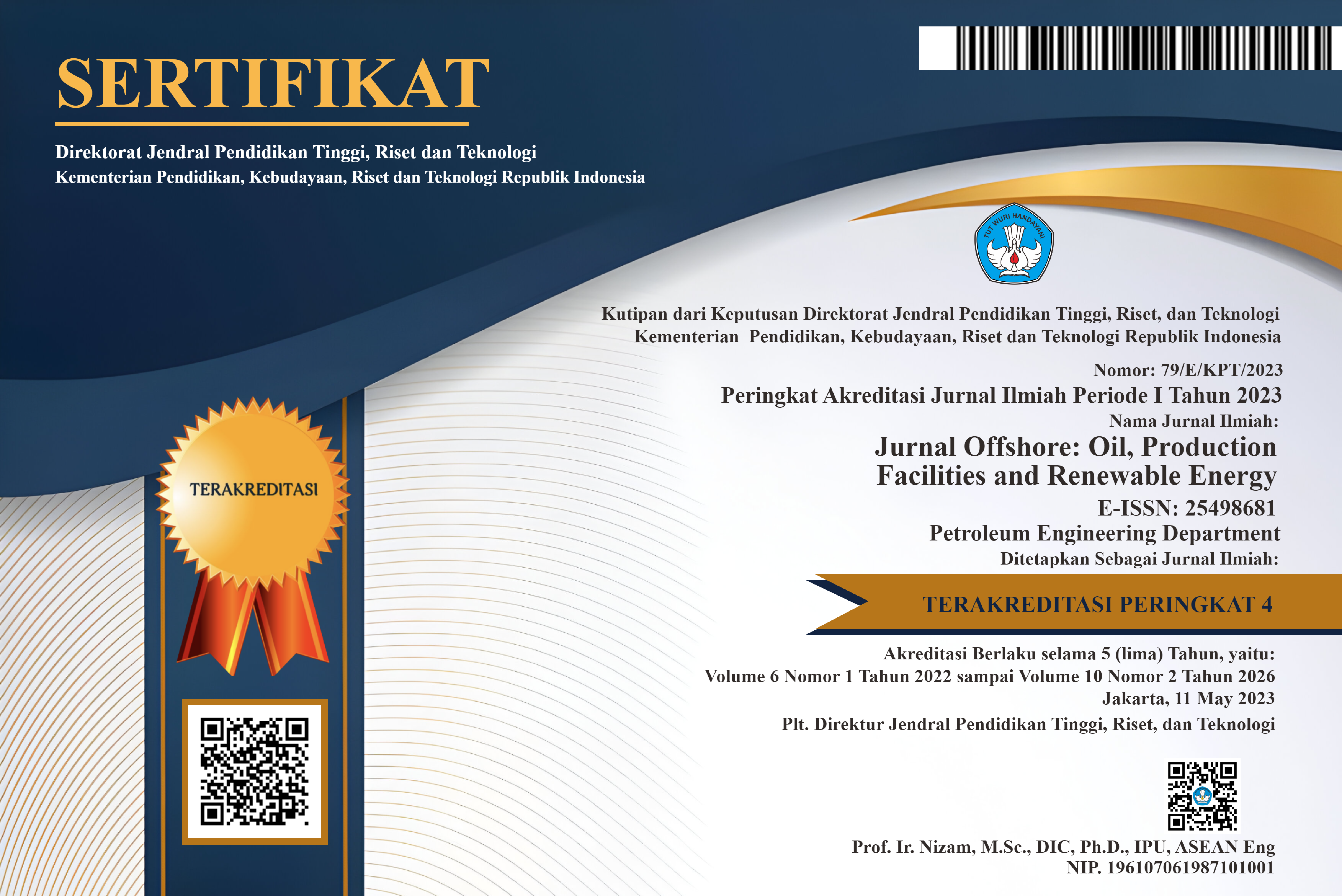Metode Inversi AVO Simultan untuk Mengetahui Sebaran Hidrokarbon Formasi Baturaja, Lapangan "Wine”, Cekungan Sumatra Selatan
DOI:
https://doi.org/10.30588/jo.v1i1.239Keywords:
inversi simultan, impedansi, lambda-rho, mu-rho, simultaneous inversion, impedanceAbstract
Data seismik 3D (CDP gather) pada daerah penelitian dilakukan proses inversi prestack yaitu inversi AVO simultan untuk mengetahui sebaran hidrokarbon. Data seismik 3D terbentang dengan jangkauan inline 1003-1302 dan xline 5002-5300. Metode inversi AVO simultan dilakukan dengan data masukan berupa angle stack yang diinversi secara bersama-sama (simultan) untuk menghasilkan impedansi-P, impedansi-S dan densitas. Dari hasil inversi impedansi-P dan inversi impedansi-S didapatkan nilai lambda-rho dan mu-rho sebagai hasil turunannya. Kisaran nilai hasil inversi impedansi-P, impedansi-S, densitas, lambda-rho dan mu-rho pada porous limestone formasi Baturaja yaitu nilai impedansi-P sekitar 11000-13500 m/s*g/cc, nilai impedansi-S sekitar 6500-7400 m/s*g/cc, nilai densitas sekitar 2,52-2,6 g/cc, nilai lambda-rho sekitar 36-70 Gpa*g/cc dan nilai mu-rho sekitar 41-59 Gpa*g/cc. Berdasarkan map slice hasil inversi impedansi-P, map slice hasil inversi impedansi-S, map slice hasil inversi densitas, map slice hasil inversi lambda-rho dan map slice hasil inversi mu-rho dapat diketahui area persebaran hidrokarbon pada formasi Baturaja. Persebaran hidrokarbon berada di sekitar sumur TT.
3D seismic data (CDP gather) in the study area was carried out a prestack inversion process, namely simultaneous AVO inversion to determine the distribution of hydrocarbons. 3D seismic data stretches with inline range 1003-1302 and xline 5002-5300. Simultaneous AVO inversion method is done with input data in the form of angle stack which is inverted together (simultaneously) to produce P-impedance, S-impedance and density. From the results of P-impedance inversion and S-impedance inversion, the values of lambda-rho and mu-rho are derived as a result of their derivatives. The range of values of P-impedance inversion, S-impedance, density, lambda-rho and mu-rho in porous limestone formation i.e. the P-impedance value around 11000-13500 m/s*g/cc, the S-impedance value around 6500-7400 m/s*g/cc, the density value around 2.52-2.6 g/cc, the lambda-value rho around 36-70 Gpa*g/cc and your value around 41-59 Gpa*g/cc. Based on the P-impedance inversion map slice, S-impedance inversion map slice, density inversion map slice, lambda-rho inversion map slice and mu-rho inversion map slice can be known the area of hydrocarbon distribution in the Baturaja formation. Hydrocarbon spread is around the TT well.
References
Hampson, D., and Russell, B.H., 2005, Simultaneous Inversion of Pre-stack Seismic Data, Geohorizons
Kazainullah, Fasih, 2007, Studi Geologi dan Geofisika Untuk Karakterisasi Reservoir Karbonat Formasi Parigi dengan Metode Inversi Simultan (Studi Kasus: Lapangan “ADIL”, Cekungan Jawa Barat Utara), Universitas Gadjah Mada: Yogyakarta.
Sukmono, S, 2000, Seismik Inversi Untuk Karakterisasi Reservoar, Institut Teknologi Bandung: Bandung.
Downloads
Published
How to Cite
Issue
Section
License
Authors retain copyright and grant the Jurnal Offshore right of first publication with the work simultaneously licensed under a Creative Commons Attribution 4.0 International License that allows others to share (copy and redistribute the material in any medium or format) and adapt (remix, transform, and build upon the material) the work for any purpose, even commercially with an acknowledgement of the work's authorship and initial publication in Jurnal Offshore. Authors are able to enter into separate, additional contractual arrangements for the non-exclusive distribution of the journal's published version of the work (e.g., post it to an institutional repository or publish it in a book), with an acknowledgement of its initial publication in Jurnal Offshore. Authors are permitted and encouraged to post their work online (e.g., in institutional repositories or on their website) prior to and during the submission process, as it can lead to productive exchanges, as well as earlier and greater citation of published work (See The Effect of Open Access).
















